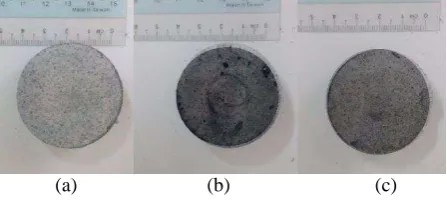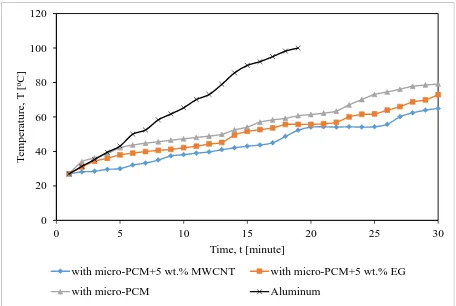Proceedings of Mechanical Engineering Research Day 2015, pp. 17-18, March 2015
__________
© Centre for Advanced Research on Energy
Thermal performance of carbon-based microencapsulated phase
change materials
A.Z.I. Abdullah1, M.F.B. Abdollah1,2,*, B.T. Tee1,2, H. Amiruddin1,2, A.K. Mat Yamin1,2, N. Tamaldin1,2
1) Faculty of Mechanical Engineering, Universiti Teknikal Malaysia Melaka,
Hang Tuah Jaya, 76100 Durian Tunggal, Melaka, Malaysia.
2) Centre for Advanced Research on Energy, Universiti Teknikal Malaysia Melaka,
Hang Tuah Jaya, 76100 Durian Tunggal, Melaka, Malaysia.
*Corresponding e-mail: [email protected]
Keywords: Phase change materials; carbon-based materials; thermal performance
ABSTRACT – The aim of this study is to investigate the effect of carbon-based materials for the thermal performance of microencapsulated phase change material (µPCM). The sample was prepared separately by mixing 5 wt.% of Multiwall Carbon Nanotube (MWCNT) and 5 wt.% Expanded Graphite (EG) with µPCM using a powder metallurgy technique. The mixed powder was then compacted into a disc with a diameter of 45 mm and thickness of 5 mm using a hot compaction technique. The thermal performance was tested according to the ASTM standard. It was found that the addition of MWCNT into µPCM can absorb heat effectively as compared to pure µPCM and µPCM/EG composite.
1. INTRODUCTION
Phase change material (PCM) is suitable to be applied as energy storage, thermal protection and passive cooling system [1]. This is because of its desirable characteristic such as high latent heat of fusion, low vapor pressure during melting, no super cooling and chemically inert and stable [2-3]. In principle, the heat generated by any system could be absorbed by the PCM by attaching it on the system. PCM acts as heat sink for the system to eliminate the heat produced. However, the PCM could melt when the temperature of the system exceeds the melting point and the high latent heat of PCM. The melting PCM causes complexity and limits the full use of its function. In order to solve the limitation, micro-encapsulated technique was employed to PCM to solve the problem. Microencapsulated phase change material (µPCM) products are very small bi-component particles consisting of a core material, the PCM and an outer shell or capsule wall that hold the melted PCM from leaking. Therefore, whether the PCM is in the liquid or solid state, the capsule itself will remain as a solid particle.
The µ PCM has disadvantage of low thermal conductivity to meet required heat exchange rates. Many techniques were proposed to improve thermal conductivity of PCM such as inserting fin, incorporating carbon based materials and adding metallic and nonmetallic materials [4]. Most researchers use core
PCM, typically Paraffin wax instead of µPCM, therefore the matrix lead to melt compare to µPCM.
Based on the above review, there are a limited number of studies [1-4] that investigate the effect of carbon-based materials on the thermal performance of µPCM. This study aims to investigate further the thermal performance between µPCM/EG and µPCM//MWCNT composites.
2. METHODOLOGY
The µPCM type of PX52 was supplied by Rubitherm Technologies, while for MWCNT and EG was supplied by Microtek Laboratories. Table 1 shows the thermal properties of the materials.
Table 1 Thermal properties of the materials
aProperties µPCM MWCNT EG
Melting temperature,
oC 52 3625 3000
Thermal conductivity,
W/m.k 0.1 3500 200
Latent heat capacity,
kJ/kg 100 - -
Density,
g/cm3 0.65 0.03 2.2
aFrom manufacturer
The samples were prepared separately by mixing 5 wt.% of MWCNT and 5 wt.% EG with µPCM using a ball mixer. The mixed powder was then compacted into a disc with a diameter of 45 mm and thickness of 5 mm using a hot hydraulic press. The samples are show in Figure 1.
Abdullah et al., 2015
18 The thermal performance of the prepared sample was tested according the modified method in correlation to the ASTM C518–10 [6]. The measurement stack of the apparatus is shown in Figure 2. The sample is placed between the hot and cold copper plates. The hot plate above the electric heater assures unidirectional heat flow from the heater up through the sample. The cold plate above the sample provides uniform temperature distribution on its surface. Unidirectional heat flow is achieved by adjusting the electric power supply to such a level that temperature of the heater is equal to the hot plate temperature. The sample was covered by aluminum. The aluminum casing was heated at 12V of nominal voltage and 5 Watt of power. All tests were performed at room temperature. The temperature of aluminum casing was recorded by using an infrared thermometer for each minute. The result was obtained in the form of the temperature profile of aluminum casing over time.
Figure 2 Measurement stack in plate apparatus.
3. RESULTS AND DISCUSSION
Figure 3 shows the temperature profiles of aluminum with and without µPCM composites. It was clearly shown that the temperature of aluminum increases over time. However, the magnitude of temperature significantly decreases when the µPCM is present. Besides, the combination of µPCM and MWCNT effectively reduce the temperature of aluminum casing to 91% over the time. This shows that the composite absorbs some amount of heat from the aluminum casing, and hence decrease the temperature. The present of MWCNT into µPCM can absorb more heat from the aluminum casing as compared to the pure µPCM and µPCM/EG composite. This is due to the fact that the MWCNT has higher thermal conductivity and larger surface area compared to EG. M. Lajvaerdi et al. [5] reported that the thermal conductivity of paraffin increases to 31% with addition of 2 wt.% of MWCNT.
4. CONCLUSIONS
In conclusion, the thermal performance of µPCM can be improved by employing carbon-based materials a s an ad d i t iv e . H o w ev er, th e µ P CM / MW CN T
composites show a great improvement in terms of heat absorption due to the fact that the MWCNT has higher thermal conductivity and larger surface area compared to EG.
Figure 3 Temperature profiles of aluminum casing over time with and without µPCM composites.
5. ACKNOWLEGEMENT
The authors gratefully acknowledge contributions from the members of the Green Tribology and Engine Performance (G-TriboE) research group. This research was supported by the grant from the Ministry of
Education Malaysia (Grant No.:
RAGS/2012/FKM/TK01/1 B00001).
6. REFERENCES
[1] S. Alhallaj, R. Kizilel, A. Lateef, R. Sabbah, M. Farid, J.R. Selman, “Novel PCM thermal management make li-ion batteries a viable option
for high power and high temperature application,”
in The 22nd International Battery Seminar & Exhibit, 2005.
[2] B. Zalba, J.M. Marin, L.F. Cabeza, H. Mehling.
“Review on thermal energy storage with phase
change: materials, heat transfer analysis and
applications,” Appl. Therm. Eng, vol. 23, no. 3, pp. 251–283, 2003.
[3] S.D. Sharma, K. Sagara, “Latent heat storage
materials and systems: a review,” International Journal of Green Energy, vol. 2, no. 1, pp. 1–56, 2005.
[4] T.P. Teng, C.C. Yu. “The effect of heating rate for phase change materials containing MWCNTs,” International Journal of Chemical Engineering and Applications, vol. 3, no.5, pp. 340-342, 2012. [5] M. Lajvardi, K. Lafdi, O. Mesalhy, “Carbon
Nanotube in Passive Cooling,” in The 4th International Conference Nanostructure, 2002. [6] ASTM C518 – 10: Standard Test Method for
Steady-State Thermal Transmission Properties by Means of the Heat Flow Meter Apparatus.
Cold plate
with micro-PCM+5 wt.% MWCNT with micro-PCM+5 wt.% EG

